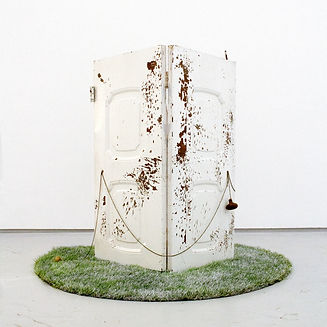
Lichtundfire's Second Resident:
Open Studio: Sunday, AUG 24, 3-6pm
Himeka Murai's two-week residency at the Lichtundfire will be a focused exploration of memory, absence, and urban identity through her unique artistic lens. Known for transforming found objects into intricate sculptural works, Murai’s practice is a direct response to her surroundings. The residency will culminate in two interconnected installations that expand on her recent piece, "Woven Absence," by creating an immersive dialogue between what is solid and what is fleeting. Her method involves collecting urban materials and weaving them into fragile, textured forms, reflecting her deep connection to the history embedded in cityscapes. By pairing a physical, built structure with a projected video, Murai aims to create a compelling contrast between tangible presence and the instability of memory. Her work embodies a practical yet poetic studio practice, directly responding to the urban environment and the personal histories it holds.

Interview with Himeka Murai
TUSSLE: During the residency, you plan to create two interconnected installations. Could you explain the relationship between the physical, entrance-like structure and the standalone door with the projected video? How do you envision visitors interacting with both pieces to experience the "tension between presence and disappearance"?
Himeka Murai: The physical presence of the door and the fragile, glue-woven surface contrasts with the flickering images of the projection. Together they create a dialogue between materiality and memory, between what is solid and what is fleeting. We live in a physical world, yet we carry intangible memories within us. The video functions like memory itself, fragmented and blurry, while the door and woven textures embody the tactile quality of remembered surfaces. I imagine visitors encountering both works as parallel experiences, moving between the solidity of material memory and the instability of its image. If I had more time, I would further develop the video component to layer in more complex imagery and create a deeper tension between these two states.
TUSSLE: The "translucent surface" made of woven hot glue sounds like a unique and fragile material. What led you to choose hot glue for this purpose, and what artistic qualities does it bring to the themes of memory, loss, and urban transformation?
Himeka Murai: I began experimenting with hot glue before moving to New York in 2019, drawn to its accessibility and ability to form organic, nest-like structures. Over time, I pushed the material further, creating three-dimensional paintings and sculptural surfaces. During a residency in Upstate New York, I discovered that hot glue could be combined with natural substances, which opened new directions for my work. Returning to it here, I see hot glue as an ephemeral material that is fragile, translucent, and easily shaped. These qualities resonate with the unstable, shifting nature of memory. Hot glue reflects how memories, like cities, are constantly layered, transformed, and eroded.
TUSSLE: You mentioned that these new works will expand on your recent piece, "Woven Absence." How does this residency project continue the conversation you started with that work, and what new ideas or techniques are you hoping to explore?
Himeka Murai: "Woven Absence" reflected on my Brooklyn neighborhood, where ongoing construction has reshaped the view outside my apartment and echoed the urban transformations I grew up witnessing in Tokyo. Both places embody disappearance through demolition and renewal, and that sense of loss drives my work. This residency project continues that conversation but shifts toward a more immersive installation, pairing structural forms with moving images. I am exploring how projection can act as memory, blurred, fragmented, and unstable, while set against the physical presence of built forms and textured surfaces. If I had more time, I would expand the projection element further, creating a multi-sensory environment that surrounds viewers and heightens the instability of memory.
TUSSLE: Your artistic statement highlights the use of found urban textures, photographic fragments, and collected debris. How do you go about sourcing these materials, and what is your process for integrating them into the installation to evoke specific memories or feelings?
Himeka Murai: My process begins with walking, observing the streets around the gallery, collecting objects, and photographing textures that resonate with me. These fragments of the city carry their own histories, which I weave into the installation. Recently, for example, I collected discarded wood structures from Gallery One Twenty Eight, a long-standing art space nearby. By incorporating these elements, I hope to highlight not only their material qualities but also the invisible traces of their stories. Rather than narrating a single event, my installations create a blurred emotional landscape where textures and images spark personal associations for each viewer.

